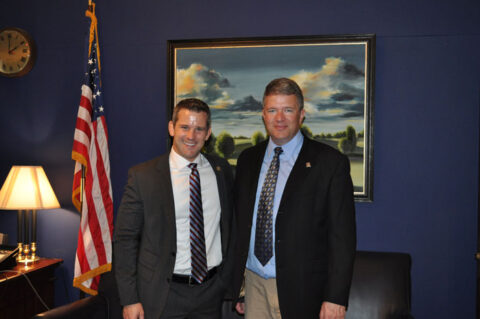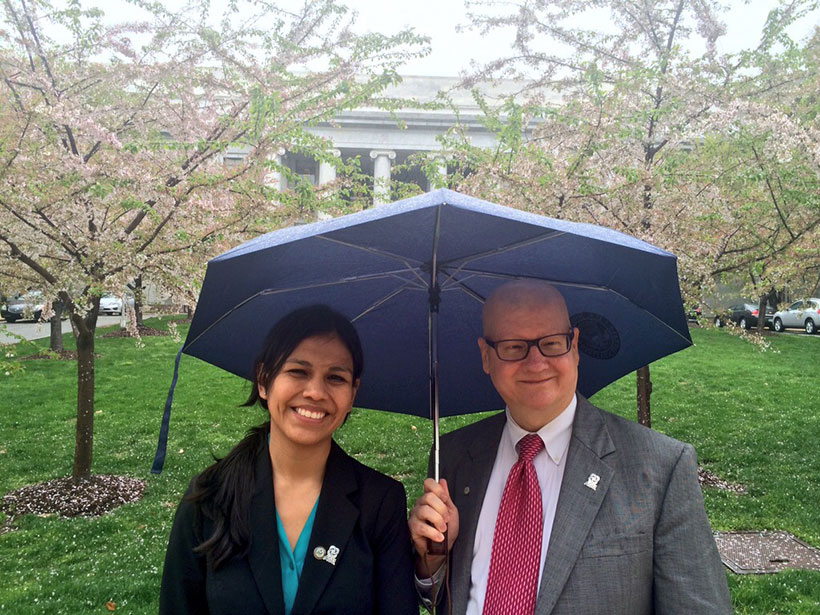Even April showers couldn’t keep American Geophysical Union (AGU) scientists away from the first-ever AGU-only Congressional Visits Day in Washington, D. C., on 13–14 April. Twenty scientists, from nine states whose legislators play leadership roles on science and funding committees, were invited to meet with lawmakers and describe the positive impacts of federal research funding on American jobs, infrastructure, and quality of life. The states represented were Alabama, Alaska, Colorado, Illinois, Maryland, Maine, Virginia, Texas, and Washington.
Morning Practice Session
On the first day, participants spent the morning preparing to meet with members of Congress and their staffs. AGU public affairs specialist Erik Hankin and manager Liz Landau gave the scientists an overview of the federal budget process, as well as the structure of congressional offices. In addition, Darius Dixon, of Politico, and Chuck Podolak, AGU’s Congressional Science Fellow with the office of Sen. Jeff Flake (R-Ariz.), treated them to a Capitol Hill insider’s perspective.
Most important, participants practiced communicating the need for strong, sustained federal investment in science.
Skits and group role-playing gave participants a chance to practice sharing their research succinctly and communicating the day’s “asks.” These included seeking an exemption for scientific and technical conferences from the current crackdown on federal conference travel and advocating for support of the American Innovation Act, which prioritizes funding for basic research. Most important, participants practiced communicating the need for strong, sustained federal investment in science.
Making the Case
Then the scientists fanned out across Capitol Hill to meet with lawmakers and congressional staff. In a total of 56 meetings, the science ambassadors described their research and why it matters to states and local districts, to the economy, and to public health and safety. In addition to advocating for science, the meetings served to open a line of communication between scientists and policy makers.

The scientists were able to put a face on their work. Representing a range of scientific fields—from geology and hydrology to space weather and paleoclimate studies—they shared the value of scientific research and the direct impact that federal research funding has on local communities.
Jeffrey McDonald, a geologist with the U.S. Environmental Protection Agency, said that he appreciated the chance to give members of Congress and their staffs a new perspective. “It was a great opportunity to talk to legislators about the interconnectedness of various science programs and the overall value of science funding, hopefully in ways they had not considered before,” he said.
Direct Impact on State Economies
Many focused on the big-picture role of Earth and space science. As an example, Ursula Ruiz Vera, a postdoctoral research associate at the University of Illinois at Urbana–Champaign who is studying how climate change affects terrestrial ecosystems, talked about how large-scale changes affect agricultural output. It’s an issue of major interest for a farm state like Illinois. “I strongly believe that scientific research is one of the most prominent ways to encourage economic growth,” she said.
The meetings sent a strong signal to Congress that scientists are interested and invested in policy.
The meetings sent a strong signal to Congress that scientists are interested and invested in policy—as well as ready and willing to share their expertise. AGU and its members are an invaluable resource for policy makers, and events like this help to make that clear.
The Congressional Visits Day is one of several AGU programs that promote the importance of science on Capitol Hill and connect scientists with their representatives. AGU and partner organizations also host briefings, exhibitions, and additional Congressional Visits Days. These include Science-Engineering-Technology Congressional Visits Day, which was held 17–18 March 2015, and Geosciences Congressional Visits Day, which will take place in late September (dates to be announced).
For more information on AGU congressional events, visit AGU’s science policy website. To find out how you can get involved, email [email protected].
AGU thanks the following members for participating in the 2015 Congressional Visits Day:
- Gary Acton, Sam Houston State University
- Kristen Averyt, University of Colorado Boulder
- Seth Campbell, University of Maine
- Doug Clark, Western Washington University
- George Clark, NASA Goddard Space Flight Center
- Katia Kontar, International Arctic Research Center
- Jurate Landwehr, The Sumanim Group
- Ramon Lopez, University of Texas at Arlington
- Kathleen Mandt, Southwest Research Institute, San Antonio
- Jeffrey McDonald, Environmental Protection Agency
- Mike Phillips, Illinois Valley Community College
- Laurie Rokke, National Environmental Satellite, Data, and Information Service, National Oceanic and Atmospheric Association
- Ursula Ruiz Vera, University of Illinois at Urbana–Champaign
- Ted Scambos, National Snow and Ice Data Center
- Elise Schultz, University of Alabama in Huntsville
- Surja Sharma, University of Maryland, College Park
- Seth Stein, Northwestern University
- Annie Tamalavage, Texas A&M University at Galveston
- Molly Tedesche, International Arctic Research Center
- Mike Wiltberger, High Altitude Observatory
—Lily Strelich, Public Affairs Intern, AGU; email: [email protected]
Citation: Strelich, L. (2015) AGU members share their science on Capitol Hill, Eos, 96, doi:10.1029/2015EO030973. Published on 5 June 2015.
Text © 2015. The authors. CC BY-NC 3.0
Except where otherwise noted, images are subject to copyright. Any reuse without express permission from the copyright owner is prohibited.

